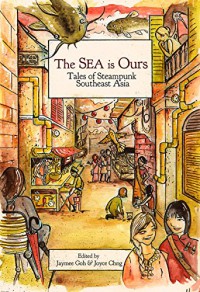
The Sea Is Ours

[I received a copy of this book through NetGalley, in exchange for an honest review.]
An interesting change of setting, mixing south-eastern Asia culture and various other aspects to engineering and more “steampunkish” elements. I appreciated this nice change of pace, so different from the typical corset & goggle aesthetics: though I still love the latter, variety is always good, and the whole steam/mechanical technology shouldn't be restricted to European or American settings.
Descriptions and characters mostly felt real enough, and I had no trouble imagining what their surroundings looked like. Some stories used “foreign” words whose meaning wasn't too difficult to guess, so it added to the immersion factor while not being overly confusing. A certain dichotomy also permeated this anthology, though in a harmonious way, in that several of the stories mixed technology with traditional or supernatural aspects: the Westerners' cold, rational technology as opposed to a technology combining magic or spirits to science. As simplistic as the first may seem, it still flowed well enough for me.
What I found lacking in this anthology is something I find both very difficult to achieve as a writer, and lacking in short stories in general: it came with a lot of excellent ideas, character concepts and backgrounds, but tended to leave the reader to dry by cutting off abruptly the narratives. I kept expecting either more of a punchline at the end of stories, or to learn that those had also been developed / were to be developed into novellas or novels later. As a result, I more than once reached the end of a story thinking “am I missing a few pages here?”
Favourite stories:
“On the Consequence of Sound”: though the ending was a bit predictable, I really liked the idea of using music to make items and ships levitate.
“The Unmaking of the Cuadro Amoroso”: exploring various ideas, such as artists that are also scientists (or is it the contrary?), science versus faith, an oppressive government, revenge, and a polyamorous relationship presented in a totally natural way.
“Working women”: a bit too abrupt to my taste in how events unfurled, however I liked its weaving of three women's stories, colliding through mechanical transformations, how society perceived them, and how they acted to (re)claim their own worth and independence.
Formatting: a few typos here and there, however I read an ARC, so this was probably to be expected. I don't know about the printed book.
 11
11


